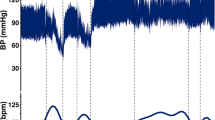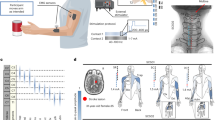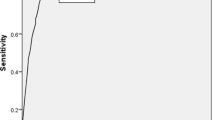Abstract
Design
Prospective cohort study.
Objectives
We aim to better understand the silent period (SP), an inhibitory counterpart to the well-known motor evoked potential (MEP) elicited by transcranial magnetic stimulation (TMS), in individuals with spinal cord injury (SCI).
Setting
Veterans Affairs Hospital in New York.
Methods
EMG responses were measured in the target abductor pollicis brevis at rest (TMS at 120% of resting motor threshold (RMT)) and during maximal effort (TMS at 110% of RMT). Participants with chronic cervical SCI (n = 9) and AB participants (n = 12) underwent between 3 and 7 sessions of testing on separate days. The primary outcomes were the magnitude and reliability of SP duration, resting and active MEP amplitudes, and RMT.
Results
SCI participants showed significantly lower MEP amplitudes compared to AB participants. SCI SP duration was not significantly different from AB SP duration. SP duration demonstrated reduced intra-participant variability within and across sessions compared with MEP amplitudes. SCI participants also demonstrated a higher prevalence of SP ‘interruptions’ compared to AB participants.
Conclusions
In a small group of individuals with chronic cervical SCI, we confirmed the well-known findings that SCI individuals have lower TMS evoked potential amplitudes and a tendency toward higher TMS motor thresholds relative to able-bodied controls. We did not observe a significant difference in SP duration between individuals with versus without SCI. However, SP duration is a more reliable outcome within and across multiple sessions than MEP amplitude.
Similar content being viewed by others
Log in or create a free account to read this content
Gain free access to this article, as well as selected content from this journal and more on nature.com
or
Data availability
Individual-level data are included as Supplementary Data 1 (by participant, averaged across sessions) and Supplementary Data 2 (by participant per session). The LabVIEW code for analyzing SP duration is deposited at https://github.com/neurorehabva/CSP_LabVIEW.
References
Fuhr P, Agostino R, Hallett M. Spinal motor neuron excitability during the silent period after cortical stimulation. Electroencephalogr Clin Neurophysiol. 1991;81:257–62.
Poston B, Kukke SN, Paine RW, Francis S, Hallett M. Cortical silent period duration and its implications for surround inhibition of a hand muscle. Eur J Neurosci. 2012;36:2964–71.
Inghilleri M, Berardelli A, Cruccu G, Manfredi M. Silent period evoked by transcranial stimulation of the human cortex and cervicomedullary junction. J Physiol. 1993;466:521–34.
Hupfeld KE, Swanson CW, Fling BW, Seidler RD. TMS-induced silent periods: a review of methods and call for consistency. J Neurosci Methods. 2020;346:108950.
Inghilleri M, Berardelli A, Marchetti P, Manfredi M. Effects of diazepam, baclofen and thiopental on the silent period evoked by transcranial magnetic stimulation in humans. Exp Brain Res. 1996;109:467–72.
Stetkarova I, Kofler M. Differential effect of baclofen on cortical and spinal inhibitory circuits. Clin Neurophysiol. 2013;124:339–45.
Barry MD, Bunday KL, Chen R, Perez MA. Selective effects of baclofen on use-dependent modulation of GABAB inhibition after tetraplegia. J Neurosci. 2013;33:12898–907.
McDonnell MN, Orekhov Y, Ziemann U. The role of GABAB receptors in intracortical inhibition in the human motor cortex. Exp Brain Res. 2006;173:86–93.
Braune HJ, Fritz C. Transcranial magnetic stimulation-evoked inhibition of voluntary muscle activity (silent period) is impaired in patients with ischemic hemispheric lesion. Stroke. 1995;26:550–3.
Classen J, Schnitzler A, Binkofski F, Werhahn KJ, Kim YS, Kessler KR, et al. The motor syndrome associated with exaggerated inhibition within the primary motor cortex of patients with hemiparetic stroke. Brain. 1997;120:605–19.
Macdonell RA, King MA, Newton MR, Curatolo JM, Reutens DC, Berkovic SF. Prolonged cortical silent period after transcranial magnetic stimulation in generalized epilepsy. Neurology. 2001;57:706–8.
Steele JD, Glabus MF, Shajahan PM, Ebmeier KP. Increased cortical inhibition in depression: a prolonged silent period with transcranial magnetic stimulation (TMS). Psychol Med. 2000;30:565–70.
Levinson AJ, Young LT, Fitzgerald PB, Daskalakis ZJ. Cortical inhibitory dysfunction in bipolar disorder: a study using transcranial magnetic stimulation. J Clin Psychopharmacol. 2007;27:493–7.
Lefaucheur JP, Drouot X, Ménard-Lefaucheur I, Keravel Y, Nguyen JP. Motor cortex rTMS restores defective intracortical inhibition in chronic neuropathic pain. Neurology. 2006;67:1568–74.
Lotze M, Laubis-Herrmann U, Topka H. Combination of TMS and fMRI reveals a specific pattern of reorganization in M1 in patients after complete spinal cord injury. Restor Neurol Neurosci. 2006;24:97–107.
Nardone R, Golaszewski S, Bergmann J, Venturi A, Prunster I, Bratti A, et al. Motor cortex excitability changes following a lesion in the posterior columns of the cervical spinal cord. Neurosci Lett. 2008;434:119–23.
Freund P, Rothwell JC, Craggs M, Thompson AJ, Bestmann S. Corticomotor representation to a human forearm muscle changes following cervical spinal cord injury. Eur J Neurosci. 2011;34:1–8.
Shimizu T, Hino T, Komori T, Hirai S. Loss of the muscle silent period evoked by transcranial magnetic stimulation of the motor cortex in patients with cervical cord lesions. Neurosci Lett. 2000;286:199–202.
Potter-Baker KA, Janini DP, Frost FS, Chabra P, Vernerin N, Cunningham DA, et al. Reliability of TMS metrics in patients with chronic incomplete spinal cord injury. Spinal Cord. 2016;54:980–90.
Wu Y-K, Levine JM, Wecht JR, Maher MT, LiMonta JM, Saeed S, et al. Posteroanterior cervical transcutaneous spinal stimulation targets ventral and dorsal nerve roots. Clin Neurophysiol. 2020;131:451–60.
Orth M, Rothwell JC. The cortical silent period: Intrinsic variability and relation to the waveform of the transcranial magnetic stimulation pulse. Clin Neurophysiol. 2004;115:1076–82.
Spitzer M, Wildenhain J, Rappsilber J, Tyers M. BoxPlotR: a web tool for generation of box plots. 2014. https://doi.org/10.1038/nmeth.2811.
Nichols TR. Distributed force feedback in the spinal cord and the regulation of limb mechanics. J Neurophysiol. 2018;119:1186–1200.
Hess A, Kunesch E, Classen J, Hoeppner J, Stefan K, Benecke R. Task-dependent modulation of inhibitory actions within the primary motor cortex. Exp Brain Res. 1999;124:321–30.
Kojima S, Onishi H, Sugawara K, Kirimoto H, Suzuki M, Tamaki H. Modulation of the cortical silent period elicited by single- and paired-pulse transcranial magnetic stimulation. BMC Neurosci. 2013;14:43.
Tinazzi M, Farina S, Tamburin S, Facchini S, Fiaschi A, Restivo D, et al. Task-dependent modulation of excitatory and inhibitory functions within the human primary motor cortex. Exp Brain Res. 2003;150:222–9.
Wilson SA, Thickbroom GW, Mastaglia FL. An investigation of the late excitatory potential in the hand following magnetic stimulation of the motor cortex. Electroencephalogr Clin Neurophysiol. 1995;97:55–62.
Grapperon AM, Attarian S. Disorders of motor neurons manifested by hyperactivity. Rev Neurol. 2017;173:345–51.
Nguyen DTA, Rissanen SM, Julkunen P, Kallioniemi E, Karjalainen PA. Principal component regression on motor evoked potential in single-pulse transcranial magnetic stimulation. IEEE Trans Neural Syst Rehabil Eng. 2019;27:1521–8.
Tadokoro N, Kiyasu K, Kasai Y, Kawasaki M, Takemasa R, Ikeuchi M. Discrepancy between functional recovery and cutaneous silent period change in surgically treated degenerative cervical myelopathy: a prospective pilot study. Spinal Cord. 2019;57:1076–83.
Funding
The study is funded by the New York State Department of Health C30599 and Craig H. Neilsen Foundation 457648.
Author information
Authors and Affiliations
Contributions
HJS and JRW: Data acquisition; data interpretation; manuscript drafting and revision. OAA: Data interpretation; manuscript revision. YKW: Data acquisition; data interpretation; manuscript revision. NYH: Study conception and design; data interpretation; manuscript drafting and revision.
Corresponding author
Ethics declarations
Conflict of interest
The authors declare no competing interests.
Statement of ethics
All procedures were approved by the Institutional Review Board of the James J. Peters VA Medical Center, Bronx, NY (HAR-15-001). We certify that all applicable institutional and governmental regulations concerning the ethical participation of human participants were followed during the course of this research.
Additional information
Publisher’s note Springer Nature remains neutral with regard to jurisdictional claims in published maps and institutional affiliations.
Supplementary information
Rights and permissions
About this article
Cite this article
Sfreddo, H.J., Wecht, J.R., Alsalman, O.A. et al. Duration and reliability of the silent period in individuals with spinal cord injury. Spinal Cord 59, 885–893 (2021). https://doi.org/10.1038/s41393-021-00649-x
Received:
Revised:
Accepted:
Published:
Issue date:
DOI: https://doi.org/10.1038/s41393-021-00649-x
This article is cited by
-
Restoring initial steps by intermittent theta burst stimulation in complete spinal cord injury patient: a case report
Spinal Cord Series and Cases (2024)
-
Neurophysiologic evaluation of patients with cervical spondylotic myelopathy
The Egyptian Journal of Neurology, Psychiatry and Neurosurgery (2022)



